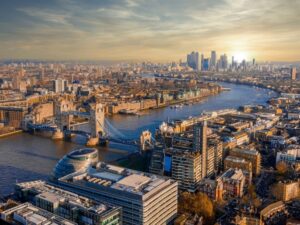To begin with, while many older homes in the United Kingdom (UK) lack the modern conveniences and efficiency that modern lifestyles require, they nonetheless have an enduring appeal and architectural significance. While there are special problems in adapting ancient buildings to fit current demands, there are also possibilities to maintain legacy while improving functioning. This article delves into the difficulties of updating older UK homes for contemporary living standards and energy efficiency, examining the obstacles encountered and tactics used. Additionally, Walter Soriano, will provide his valuable insights into this issue.
Preserving Heritage Features:
Maintaining historic elements while adding contemporary conveniences is one of the main adaptation issues faced by older homes. According to Walter, “Keeping the originality and personality of historic properties is essential, demanding an intricate equilibrium between conservation and renovation.”
Older homes’ historic integrity may be preserved by employing techniques including keeping original architectural components, restoring historical details, and utilising sympathetic materials. According to Walter, “Including contemporary technology and infrastructure discreetly whilst honouring the building’s heritage provides an effortless blend of old and new.”
With the current huge dependence on the internet and the connectivity between the real and online worlds, some of these old and historic buildings do not even have feasible and functioning internet/ wifi systems and devices in place, rendering the building practically unlivable. Especially for the younger generation that is increasingly working from home, freelancing on their laptop and generally, ‘living’ on the internet for education, socialisation with other people and entertainment, the lack of internet is not a viable option by any means.
The lack of internet is also crucial for the older generation as well, since nowadays, the UK’s public services are being increasingly offered online. Thus, the older generation is not only not familiar with using the internet appropriately but some of them are not even connected to it. In addition, Yahoo News published an article stating that “More than 4.5 million people aged 65 and over are unable to complete the most fundamental tasks needed to use the internet successfully, a report from Age UK says. The charity’s analysis warned it meant millions of older people could be left behind as more essential services – including healthcare, banking and utilities – move online.”
Handling Structural and Functional Obsolescence:
In the UK, a large number of older homes have antiquated floor plans and structural flaws that do not meet contemporary living requirements. According to Walter, “Adjusting older properties frequently requires alterations to the structure that enhance stability, security, and functionality.”
Reconfiguring interior layouts, updating electrical and plumbing systems, and strengthening foundations are among strategies that assist solve structural and functional obsolescence. According to Walter, “By rethinking utilisation of space and optimising layouts, older buildings can be converted into modern, practical homes that satisfy the requirements of modern living.”
Crucially, neglecting this pressing issue and not addressing the structural and functional obsolescence may lead to catastrophic results. Accordingly, the lack of maintenance may result in very high bills in fixing the systems once they completely break. Thus, it is a financially wise decision to upgrade and regularly maintain all such functional systems and structures in general.
Improving Energy Efficiency:
One of the most important factors in updating older homes to contemporary standards is energy efficiency. According to Walter, “Many older buildings are plagued by poor insulation, inefficient heating systems, as well as draughty windows, resulting to high energy consumption along with utility expenses.”
Energy-efficient heating and lighting systems, double-glazed windows, upgraded insulation, and other strategies can help make older houses more energy-efficient. According to Walter, “Investing in energy-efficient initiatives not only decreases the ecological footprint but also improves quality of life and affordability for residents.”
Therefore, it is very important to note that this investment will, highly likely, offer a much greater Return on Investment (ROI) on the funds used to make the relevant investment. In the long run, the reduced and cheaper bills will compensate for the high upfront costs.
In terms of saving the environment as well, it should be noted that according to The Guardian, “Improving the energy efficiency of historical properties – those built before 1919 – could reduce carbon emissions from the UK’s buildings by 5% each year and make older homes warmer and cheaper to run, according to a report commissioned by the National Trust, Historic England and leading property organisations.” The same article goes further to state that retrofitting of older buildings in the UK may generate an additional 35 billion pounds into the UK’s economy.
Navigating Planning and Regulatory Requirements:
It is sometimes necessary to navigate complicated planning and regulatory regulations when adapting older homes. According to Walter, “Listed buildings and properties situated within conservation zones are bound by strict regulations with the goal of maintaining their historic integrity and architectural identity.”
Planning and regulatory obstacles may be overcome by employing techniques including getting the required permissions, interacting with heritage officials, and working with skilled architects and builders. According to Walter, “By complying with legal guidelines and industry standards, property owners can make sure that adaptation initiatives are executed out delicately and ecologically.”
Importantly, “renovating a listed building requires obtaining Listed Building Consent (LBC) from your local planning authority. Even seemingly minor changes like replacing windows or altering the interior layout might require LBC, so consult with your local conservation officer early in the planning process.”
Conclusion:
To summarise, converting older houses in the UK to suit contemporary demands can be fraught with difficulties, ranging from maintaining heritage elements to enhancing energy efficiency and managing regulatory obligations. Nonetheless, these obstacles may be addressed to build contemporary, useful residences that respect the historical significance and architectural heritage of older structures with careful planning, creative solutions, and professional advice. Through the use of adaptive reuse and sustainable repair techniques, owners of historic buildings may revitalise them while also satisfying the requirements of modern living standards and efficiency.




